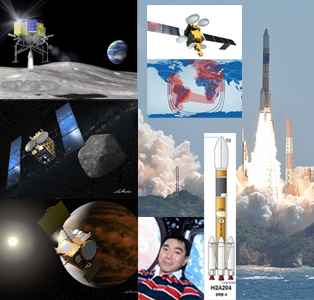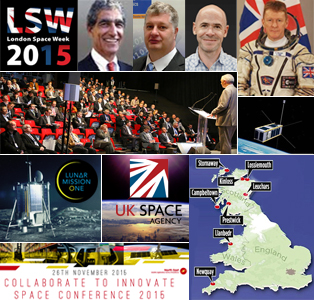Japan Space Enterprise Increasing, and More Collaborative Globally
Launch of Japan H-2A F29 rocket from Tanegashima Space Center on island shores at the edge of the Pacific, is set to raise the Telesat Telstar 12 Vantage. This powerful new high throughput communications satellite replaces the old Telstar 12 to enhance coverage over the Americas, Europe, Africa and the Middle East from geostationary orbit at 15° West. If completed this will be the 23rd straight successful H-2A flight. The JAXA Hayabusa 2 “Peregrine Falcon” robotic spacecraft is set for Earth gravity assist flyby December 3, beginning its 2nd year on a round-trip mission to Asteroid 162173 Ryugu. The probe is expected to reach the target in July 2018, survey for ~1.5 years, sample surface material, and depart in Dec 2019 for return to Earth Dec 2020. The wayward JAXA Akatsuki “Dawn” mission is expected to recover soon, using its small attitude-control thrusters to start maneuvering into a highly elliptical orbit around Venus Dec 7, after having overshot the planet on its first attempt in Dec 2010 when the main engine failed during a critical orbital-insertion burn. Also on the manifest is SLIM (Smart Lander for Investigating Moon) in 2019. Japan continues to advance international cooperation in both the private and public space sectors directly with USA, Canada, Europe, Russia, and across the Asia Pacific as well as through existing architectures such as APRSAF, COPUOS, CEOS, ISU, AIT and the United Nations. (Image Credit: JAXA, Telesat, NASA); Pictured: JAXA Astronaut Kimiya Yui, currently aboard ISS.
|
MONDAY
|

![]() = All times
= All times
for terrestrial events in local time unless noted.
![]() = All times for international terrestrial events in local time unless noted.
= All times for international terrestrial events in local time unless noted.
![]() = All times for space events, and…
= All times for space events, and…
![]() = All times for international space / astro events in Hawaii Standard Time unless noted. Add 10 hours to obtain UT (‘Universal Time;’ Greenwich, England).
= All times for international space / astro events in Hawaii Standard Time unless noted. Add 10 hours to obtain UT (‘Universal Time;’ Greenwich, England).
Weekly Planet Watch – Evening Planets: Uranus (S), Neptune (S); Morning Planets: Venus (E), Mars (E), Jupiter (E).
UK Space Exploration Emphasized by London Space Week, Astronaut Tim Peake, Potential Spaceport
|
Continued from…
TUESDAY
|
![]() Nov 24-25 — Australia Telescope National Facility (CSIRO), Sydney, Australia: Australia Telescope Users Committee (ATUC) Meeting.
Nov 24-25 — Australia Telescope National Facility (CSIRO), Sydney, Australia: Australia Telescope Users Committee (ATUC) Meeting.
![]() Nov 24-27 — European Southern Observatory, ESA, Garching, Germany: Science Operations 2015: Science Data Management – An ESO/ESA Workshop.
Nov 24-27 — European Southern Observatory, ESA, Garching, Germany: Science Operations 2015: Science Data Management – An ESO/ESA Workshop.
![]() Nov 24 – Dec 22 — IEEE, edX, Online: Course: From Goddard to Apollo: The History of Rockets, Part 1; with instructor Burton Dicht.
Nov 24 – Dec 22 — IEEE, edX, Online: Course: From Goddard to Apollo: The History of Rockets, Part 1; with instructor Burton Dicht.
![]() Nov 24 — Mercury: 2.7° SSW of Saturn, 16:00.
Nov 24 — Mercury: 2.7° SSW of Saturn, 16:00.
![]() Nov 24 — Amor Asteroid 2015 VH2: Near-Earth flyby (0.024 AU).
Nov 24 — Amor Asteroid 2015 VH2: Near-Earth flyby (0.024 AU).
![]() Nov 24 — Apollo Asteroid 2015 RQ82: Near-Earth flyby (0.074 AU).
Nov 24 — Apollo Asteroid 2015 RQ82: Near-Earth flyby (0.074 AU).
![]() Nov 24 — Amor Asteroid 2011 YS62: Near-Earth flyby (0.092 AU).
Nov 24 — Amor Asteroid 2011 YS62: Near-Earth flyby (0.092 AU).
WEDNESDAY
![]() Nov 25 — ISS, Progress M-29M Reboost, LEO: ISS to be boosted by Progress M-29M in preparation for Cygnus Orb-4 arrival planned for Dec 6.
Nov 25 — ISS, Progress M-29M Reboost, LEO: ISS to be boosted by Progress M-29M in preparation for Cygnus Orb-4 arrival planned for Dec 6.
![]() Nov 25 — Cassini, Saturn Orbit: Spacecraft conducts Orbital Trim Maneuver #432 today
Nov 25 — Cassini, Saturn Orbit: Spacecraft conducts Orbital Trim Maneuver #432 today
![]() Nov 25 — British Interplanetary Society, London, United Kingdom: Lecture: The Brits Who Got the Americans to the Moon – Or the NASA Cricket Team! presented by Dave Wright.
Nov 25 — British Interplanetary Society, London, United Kingdom: Lecture: The Brits Who Got the Americans to the Moon – Or the NASA Cricket Team! presented by Dave Wright.
![]() Nov 25-27 — Royal Aeronautical Society – Australian Division and Engineers, National Aerospace Societies of Korea (KSAS), China (CSAA), Japan (JSASS), Cairns, Queensland, Australia: Asia-Pacific International Symposium on Aerospace Technology (APISAT-2015).
Nov 25-27 — Royal Aeronautical Society – Australian Division and Engineers, National Aerospace Societies of Korea (KSAS), China (CSAA), Japan (JSASS), Cairns, Queensland, Australia: Asia-Pacific International Symposium on Aerospace Technology (APISAT-2015).
![]() Nov 25 — Moon: 8.5° S of Pleiades, 16:00; Full (Hunter’s / Beaver Moon), 12:44.
Nov 25 — Moon: 8.5° S of Pleiades, 16:00; Full (Hunter’s / Beaver Moon), 12:44.
![]() Nov 25 — Mercury: At aphelion (0.4667 AU from Sun), 08:00.
Nov 25 — Mercury: At aphelion (0.4667 AU from Sun), 08:00.
![]() Nov 25 — Aten Asteroid 2009 WB105: Near-Earth flyby (0.038 AU).
Nov 25 — Aten Asteroid 2009 WB105: Near-Earth flyby (0.038 AU).
THURSDAY
![]() Nov 26 — Astrosat, Airbus Defence & Space, Catapult, The Knowledge Transfer Network, Newcastle-upon-Tyne, United Kingdom: Collaborate to Innovate Space Conference 2015.
Nov 26 — Astrosat, Airbus Defence & Space, Catapult, The Knowledge Transfer Network, Newcastle-upon-Tyne, United Kingdom: Collaborate to Innovate Space Conference 2015.
![]() Nov 26 — Moon: 0.68° NNW of Aldebaran, 00:00.
Nov 26 — Moon: 0.68° NNW of Aldebaran, 00:00.
![]() Nov 26 — Mars and Neptune: At heliocentric opposition, 10:00.
Nov 26 — Mars and Neptune: At heliocentric opposition, 10:00.
![]() Nov 26 — Mercury: 3.3° NNE of Antares, 21:00.
Nov 26 — Mercury: 3.3° NNE of Antares, 21:00.
FRIDAY
![]() Nov 27-29 — Kennedy Space Center Visitor Center, NASA, KSC FL: Fly with an Astronaut; tour of KSC and Apollo/Saturn V Center with Astronaut Jon McBride.
Nov 27-29 — Kennedy Space Center Visitor Center, NASA, KSC FL: Fly with an Astronaut; tour of KSC and Apollo/Saturn V Center with Astronaut Jon McBride.
![]() Nov 27 — Moon: 5.9° S of M35 cluster, 13:00.
Nov 27 — Moon: 5.9° S of M35 cluster, 13:00.
![]() Nov 27 — Apollo Asteroid 2004 BG41: Near-Earth flyby (0.077 AU).
Nov 27 — Apollo Asteroid 2004 BG41: Near-Earth flyby (0.077 AU).
![]() Nov 27 — Apollo Asteroid 2011 HJ7: Near-Earth flyby (0.089 AU).
Nov 27 — Apollo Asteroid 2011 HJ7: Near-Earth flyby (0.089 AU).
SATURDAY
![]() Nov 28 — Universal Space Network, Uwingu, Horsham PA: “Beam Me to Mars” message transmission to be sent through Universal Space Network at a rate of 1M bits per second to Mars in celebration of 50th launch anniversary of the first successful mission to Mars, NASA Mariner 4.
Nov 28 — Universal Space Network, Uwingu, Horsham PA: “Beam Me to Mars” message transmission to be sent through Universal Space Network at a rate of 1M bits per second to Mars in celebration of 50th launch anniversary of the first successful mission to Mars, NASA Mariner 4.
![]() Nov 28 — Moon: 14.8° S of Castor, 22:00.
Nov 28 — Moon: 14.8° S of Castor, 22:00.
![]() Nov 28 — Venus: At perihelion (distance 0.7184 AU), 23:00.
Nov 28 — Venus: At perihelion (distance 0.7184 AU), 23:00.
SUNDAY
![]() Nov 29 – Dec 4 — American Astronomical Society, Waikoloa HI: Conference: Extreme Solar Systems III.
Nov 29 – Dec 4 — American Astronomical Society, Waikoloa HI: Conference: Extreme Solar Systems III.
![]() Nov 29 — Moon: 11.3° S of Pollux, 04:00.
Nov 29 — Moon: 11.3° S of Pollux, 04:00.
![]() Nov 29 — Venus: 4.2° NNE of Spica, 14:00.
Nov 29 — Venus: 4.2° NNE of Spica, 14:00.
![]() Nov 29 — Saturn: At conjunction with Sun, 20:00.
Nov 29 — Saturn: At conjunction with Sun, 20:00.

